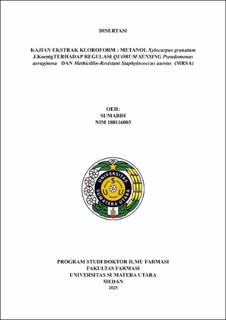| dc.description.abstract | Background: Pseudomonas aeruginosa and Methicillin-Resistant Staphylococcus aureus (MRSA) are pathogenic bacteria that play a significant role in antibiotic resistance. The discovery of effective and safe natural remedies has become essential in addressing this resistance. The nyirih plant (Xylocarpus granatum J.Koenig) has been traditionally used in medicine; however, scientific evidence regarding its antiquorum sensing activity remains limited.
Objective: This study aims to evaluate the antiquorum sensing potential of chloroform:methanol extracts derived from the leaves and bark of X. granatum against the growth of P. aeruginosa and MRSA, as well as to perform chemical profiling of the extracts.
Methods: The extract was obtained from dried and ground leaves and bark, which were then macerated with chloroform:methanol (2:1). The Total lipid s (TL) obtained were partially saponified with a 2 M KOH solution in 50% ethanol at 65°C for 24 hours and then extracted with n-hexane. The obtained portion is referred to as the nonsaponifiable lipid extract (NSL), which was subjected to secondary metabolite screening using GCMS and LCMSMS methods. TL and NSL were tested for their activity against P. aeruginosa and MRSA, including the determination of minimum inhibitory concentration (MIC) and minimum bactericidal concentration (MBC). The active extract was evaluated for its activity in inhibiting biofilm formation, swarming motility, protease activity, virulence production, and molecular docking.
Results: The leaves contain a dominant terpene compound (48.9%), while the bark contains 39.6%. The biofilm formation activity, swarming motility, and virulence factors of P. aeruginosa and MRSA can be inhibited by TL and LTS at varying degrees, supported by information on the affinity energy values and ligand efficiency of most compounds interacting with the active sites of LasI, LasR, and PqsR quorum sensing proteins in P. aeruginosa, while in MRSA, the interactions involve agrA, agrC, SarA, hydroxyproline, and the squalene synthase enzyme.
Conclusion: The compounds benzo[h]quinoline, 2,4-dimethyl, γ-sitosterol, 9,19-cyclolanost-24-en-3-ol, (3β), cycloartenol acetate, isospathulenol, alpha-tocopherol, α-cadinol, α-calacorene bisacumol, and n-Butyl palmitate show potential as agents quorum sensing inhibitor P. aeruginosa and MRSA resistance. | en_US |


